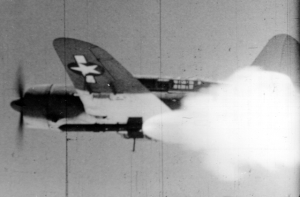Tiny Tim (rocket)
| Tiny Tim | |
|---|---|

Curtiss SB2C Helldiver firing a Tiny Tim rocket
|
|
| Type | Rocket |
| Place of origin | United States |
| Service history | |
| In service | 1944-1951 |
| Used by | United States Navy |
| Wars | World War II, Korean War |
| Production history | |
| Designer | Caltech, NOTS |
| Designed | 1944 |
| Specifications | |
| Weight | 1,255 lb (569 kg) |
| Length | 10.25 ft (312 cm) |
| Width | 36 in (91 cm) (across fins) |
| Diameter | 11.75 in (29.8 cm) |
|
|
|
| Maximum firing range | 1,600 yd (1,500 m) |
| Warhead | TNT |
| Warhead weight | 148.5 lb (67.4 kg) |
|
|
|
| Engine | Solid-propellant rocket 3,000 lbf (13 kN) for 1 sec |
| Speed | 550 mph (245.8 m/s) |
The Tiny Tim was an American air-to-ground rocket used near the end of the Second World War. One source states it was built in response to a United States Navy requirement for an anti-shipping rocket capable of hitting ships outside of their anti-aircraft range, with a payload capable of sinking heavy shipping. However, according to the China Lake Weapons Digest, the Tiny Tim was manufactured using 11.75-inch pipe, which was chosen because it was already being manufactured. Used oil field 11.75-inch pipe was acquired for the prototypes. Also the 11.75-inch size was of interest in the development because there was already available a 500-pound semiarmor-piercing bomb that was adaptable for use as the warhead for the rocket. One of the rocket project scientists commented on the shortage of the piping “. . . we were reduced for a time to the expedient of salvaging [oil-well casing] from abandoned oil wells.”
Jack Latimer
... designed by the Caltech-China Lake team as a bunker-buster, Tim was the first large aircraft rocket, and, although it saw only limited service in WWII, it helped form the foundations of many postwar developments in rocketry.
The Tiny Tim's diameter of 11.75 in (29.8 cm) was the first Allied aerial rocket to have a larger calibre than the Luftwaffe-deployed bomber destroyer aerial rocket ordnance, the BR 21 of 21 cm (8-1/4 in) calibre. The Tiny Tim's large diameter allowed a sizable 148.5 lb semi-armor-piercing high-explosive warhead, some 60 lbs (27 kg) heavier than the BR 21's 40.8 kg (90 lb) warhead. The Tiny Tim had a maximum range of 1,500 meters (1,640 yards), some 200 meters greater than the BR 21's time-fuze limited 1.2 km detonation range from launch.
They were used by the United States Navy and United States Marine Corps near the end of the war during the battle of Okinawa, and during the Korean War. A problem with the sheer power of the rocket motor causing damage to the firing aircraft was resolved by having the Tiny Tim drop like a bomb, and a lanyard attached to the rocket would snap, causing the rocket to ignite. Common targets included coastal defense guns, bridges, pillboxes, tanks, and shipping. An ambitious operation to use the Tiny Tim against German V-1 sites as part of Operation Crossbow, code-named Project Danny, was planned but cancelled before the squadrons assigned could be deployed to Europe.
...
Wikipedia
